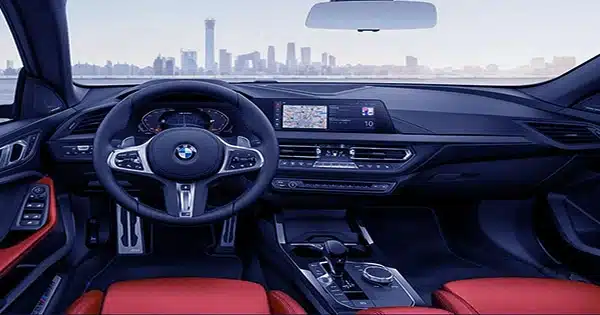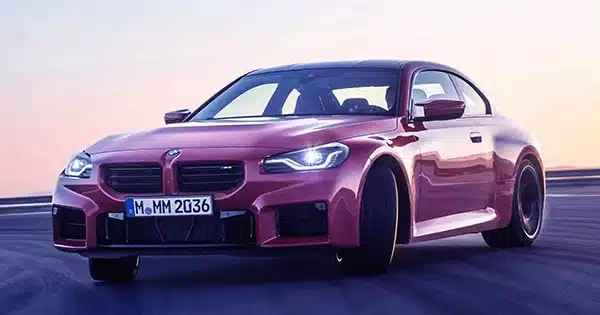Do you find it difficult to make sense of today’s flood of hefty, insanely powerful EVs? Is it possible to experience anxiety and melancholy when attempting to distinguish one SUV’s body type from another? Then you could have the transitional automotive disorder. Inquire with a local BMW dealer to see whether the second-generation M2 coupe is suited for you. (Side effects may include joyous laughter at extralegal speeds, increased tolerance for g-forces, and cravings for empty, curvy roads.)
The prescription for the new M2 is simple: Scale down the workings of one of BMW M’s greatest cultures, the one-size-up M4, to a more fun size. Although it’s wheelbase and total length have expanded by 2.1 and 4.1 inches, respectively, to 108.1 and 180.3 inches, this little rear-wheel-drive riot of a vehicle still has two stifling back seats. It is based on the new 2-series coupe made in Mexico. Additionally, it has a somewhat shorter stature now but a beam that is 1.3 inches bigger, as well as wider front and rear tracks that now match the M4s. If you want all-wheel drive, you’ll need to downgrade to the M240i variant because the M2 only has rear-wheel drive. Despite the styled M2 bumpers’ ducting appearing disconnected from some angles, the upright three-box coupe’s significantly flared fenders give it the swagger of a gorgeous vintage IMSA racer. Thankfully, the bucktoothed jaw of the older brother is not present.

BMW did merge nearly all of the M4’s (and physically comparable M3 sedans) other important components into the M2, including the 3.0-liter twin-turbo inline-six. Despite the fact that the new car’s estimated curb weight has increased significantly to around 3800 pounds, BMW’s S58 mill produces a robust 453 horsepower in this application—20 horses less than the standard M4 but 48 more than the outgoing M2 Competition’s S55 inline-six produced (it’s a stronger dosage than even the limited-edition 444-hp M2 CS provided). A six-speed manual transmission is still standard, with a free ZF-sourced eight-speed automatic replacing the previous seven-speed dual-clutch unit (we haven’t tried the auto yet). Both systems achieve 19 mpg combined, or about the same as the M2 Competition from the previous generation, according to the EPA. Not that we need any more motivation to choose the DIY gearbox, but the EPA estimates that it will get a mile more miles per gallon on the interstate.
The self-shifting M2 should return an estimated 3.6-second 60-mph time, comparable to the previous automated M2 CS we tested. Working the manual’s accurate but rather rubbery shifter through its gates will most certainly cost a few tenths of a second, but we don’t mind. This gearbox is still one of BMW’s most effective cures for driving monotony, and the M2’s pedals are perfectly positioned for the heel-and-toe dance. It’s business as usual for this fantastic straight-six, from the engine’s musical drive toward its 7200-rpm redline to the silky growl it produces through its quad tailpipes. The key distinction is that the M2’s thrust develops more gradually as revs rise, even though it produces the same 406 pound-feet of torque at 2650 rpm as the M4’s headier tune. It is simpler to add power without disrupting the car’s grip on the road since there is a little less turbo pressure to control (17.4 psi as opposed to the original M4’s 18.9 psi).
The body shell of the M2 has been strengthened to house the M4’s rear axle with its electronically controlled limited-slip differential, as well as the suspension links, adaptive dampers, and brakes. (15.0-inch rotors with six-piston calipers in front, 14.6-inch single-piston units out back). Minor tweaks, such as springs that are somewhat stronger in the front and softer in the rear, assist to mitigate the M2’s inclination to rotate on a 4.4-inch shorter wheelbase than its big brother. However, the 19-inch front and 20-inch rear Michelin Pilot Sport 4S summer tires from the M4 remain. A minimum of 1.0 g of skidpad grip should be attainable. This is the entry-level model for the M brand, thus it won’t have carbon-ceramic brakes, with a beginning price of $63,195, which is $3300 more than the previous M2 Competition but $12,500 less than the M4’s original pricing. But there will be track-focused Michelin Pilot Sport Cup 2 tires available, and a lighter carbon-fiber top is also a possibility.
The business-casual inside is dominated by BMW’s Curved Display, which combines a 12.3-inch digital instrument cluster and 14.9-inch central touchscreen. It has many of the temperature controls that formerly had separate buttons and switches. Despite the extra width and legroom up front, you’ll find yourself wearing this vehicle more than sitting in it, especially if you opt for the $9900 Carbon option and its hard-shell M Carbon bucket seats—we’d avoid them unless you plan to attend track days on a regular basis. Despite being ultra-supportive and promising a 24-pound weight loss, their stiff padding and lack of lumbar adjustability hurt our lower backs. The softer basic sport seats are significantly more comfortable, with still-generous side bolsters that kept us snuggly in place.
The M2’s several drive modes can be confusing at first, but the overarching Sport and Track modes (there’s also a default Comfort option) give a simpler gauge display that’s easier to see at speed. Combine the sportiest engine programming with the softest suspension option, as the M2’s ride remains rigid and short in travel, but with enough compliance to avoid feeling savage over smoother ground. We also advise turning off the manual’s rev-matching function, putting the steering response to Comfort (Sport adds effort but not tactility), and leaving the brake pedal feel alone (we couldn’t identify a difference between modes). The improved stability-control system with 10 phases of traction-control intervention is more welcome than the M4’s Drift Analyzer, which is available to score your slides around a racetrack.
Most importantly, the M2 nevertheless saturates your senses as it wriggles over uneven ground, allowing you to carefully modify its attitude with the throttle thanks to its surge of a middle power. The chassis takes a set and cleanly orients itself over mid-corner bumps, providing a snappy turn-in response while discreetly signaling weight transfers to your backside. Given that it uses the same variable steering technology as the M4, its bulky steering wheel has a lighter feel than, say, the one on a Porsche 718. However, overall refinement and stability have increased to the advantage of driver confidence, making the tenacity of this Bavarian muscle coupe more bearable.
Transitional automotive disease has yet to be cured by science, as it spreads organically in the free market, fueled by environmental and cultural pressures. The new M2, however, delivers strong relief, successfully targeting the sections of the brain linked with pleasure and fine motor control, due in large part to its plentiful raid on BMW’s parts bin. This is a powerful therapy for the driver’s soul.












